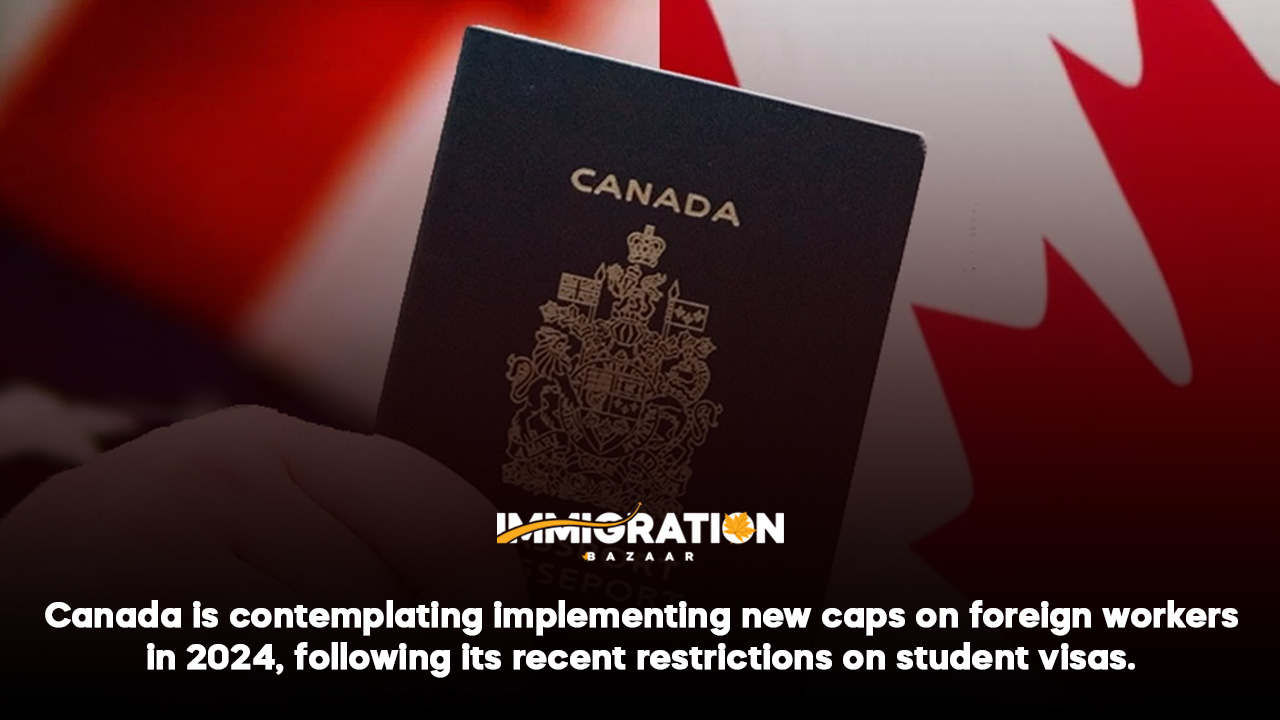Canada is contemplating implementing new caps on foreign workers in 2024, following its recent restrictions on student visas. This decision comes in response to rising concerns about the strain on the housing market, labor market pressures, and public services. These measures represent a significant shift in Canada’s immigration strategy, which has historically been one of the most welcoming in the world. If the proposed caps are enacted, it could have wide-reaching implications for international workers, employers, and Canada’s broader economic landscape.
Background: Canada’s Immigration Strategy and Its Challenges
Canada has long been known for its open-door immigration policies. Immigration is a key pillar of Canada’s economic growth, contributing significantly to its workforce and population growth. In 2021, Canada welcomed over 400,000 new permanent residents, setting an ambitious target to bring in more immigrants to address labor shortages and stimulate economic development. International students, temporary foreign workers, and permanent immigrants play a crucial role in bolstering sectors such as healthcare, technology, agriculture, and manufacturing.
However, the rapid growth in immigration has raised concerns about the country’s ability to accommodate this influx, particularly in terms of housing availability, public services, and labor market stability. As Canada’s major cities, like Toronto and Vancouver, grapple with skyrocketing housing prices, public debate has intensified over the country’s capacity to balance immigration with adequate infrastructure and resources. In response to these concerns, the Canadian government has started to reassess its immigration policies, with potential caps on foreign workers and other restrictions on visas being considered.
Recent Changes in Student Visa Policies
In 2023, Canada introduced significant changes to its student visa policy, tightening the criteria for international students. The government’s primary concern was that the rising number of international students, many of whom stay on for work opportunities after graduation, was contributing to housing shortages and increased competition for local jobs. Some student visa holders were suspected of using their visas primarily as a pathway to permanent residency, further straining public resources.
By tightening student visa regulations, the government sought to ensure that those entering Canada on student visas were genuinely committed to studying and not solely looking for work opportunities. This move was seen as a precursor to the broader reforms being discussed, including the potential introduction of caps on work permits for foreign workers.
Proposal for Caps on Foreign Workers
In 2024, Canada is considering extending immigration reform to include caps on foreign workers. This would mark a departure from Canada’s previously more open and flexible policies regarding temporary foreign workers (TFWs). The proposed caps are intended to manage the influx of foreign workers by limiting the number of work permits issued annually. This reform comes in response to growing pressures from multiple sectors of Canadian society:
- Labor Market Pressures: Canada faces an ongoing debate about how to balance its need for foreign labor with concerns about job competition for local workers. While the country’s aging population and low birth rate mean that many industries rely on foreign workers to meet demand, some argue that unchecked immigration is driving down wages and limiting job opportunities for Canadian citizens.
- Housing Shortages: The Canadian housing market is facing a critical shortage of affordable housing, particularly in urban centers. The influx of immigrants has contributed to higher demand for housing, driving up prices and making it harder for both immigrants and local Canadians to afford homes. As more international workers and students move to cities, the strain on the housing supply is exacerbated, prompting the government to rethink its immigration policies.
- Public Services and Infrastructure: With more immigrants arriving each year, Canada’s healthcare system, public transportation, and other services are feeling the strain. Some communities have expressed concerns that the country’s infrastructure is not equipped to handle such rapid population growth, leading to overcrowded services and longer wait times for medical care and public amenities.
Given these challenges, the Canadian government is weighing the benefits of immigration against its social and economic costs. By placing caps on foreign workers, the government aims to ensure that immigration levels are more in line with the country’s ability to provide housing and public services.
Impact of Caps on Foreign Workers
If enacted, caps on foreign workers would have wide-reaching implications for several key stakeholders.
-
International Workers
For international workers, the caps could significantly limit opportunities to work in Canada. Historically, Canada has been one of the most attractive destinations for skilled workers, offering pathways to permanent residency and citizenship. The proposed caps, however, would make it more difficult for workers to secure employment in Canada.
Many foreign workers rely on temporary work permits as a means to gain valuable international experience and, in many cases, transition to permanent residency. Caps on foreign workers could mean fewer opportunities for such transitions, forcing workers to explore other countries or face increased competition for limited permits.
-
Employers and Industry
For employers, the introduction of caps on foreign workers could exacerbate labor shortages in key sectors. Many Canadian industries, particularly agriculture, healthcare, and construction, depend on temporary foreign workers to meet labor demands. In the absence of sufficient local labor, industries may struggle to fill vacancies, leading to decreased productivity and potential economic slowdowns.
Sectors like technology, engineering, and skilled trades could also feel the impact. Canada’s booming tech industry, for example, has relied heavily on skilled foreign workers to maintain its competitive edge in the global market. Limiting access to international talent may hamper growth and innovation in these sectors.
-
The Economy
On a broader level, limiting the number of foreign workers could have mixed effects on the Canadian economy. On the one hand, reducing immigration levels may ease the strain on the housing market and public services, helping to stabilize housing prices and alleviate overcrowding in certain areas. On the other hand, capping work permits could lead to labor shortages, hindering economic growth in industries that rely on foreign labor.
Canada’s economy, especially in sectors such as technology, research, and healthcare, has benefited from attracting top international talent. Curtailing the availability of foreign workers could reduce the country’s ability to compete globally and limit its capacity to innovate.
-
Canada’s Immigration System
Canada’s immigration system could face additional pressure if caps on foreign workers are implemented. Many individuals who come to Canada on temporary work permits do so with the hope of transitioning to permanent residency. Caps on foreign workers may force individuals to reconsider Canada as a destination for long-term settlement, opting instead for countries with more open immigration policies.
Moreover, it could create bottlenecks within the immigration system as workers race to secure one of the limited work permits available each year. This could lead to longer processing times and increased frustration for applicants.
Future of Canadian Immigration Policy
The introduction of caps on foreign workers represents a broader shift in Canadian immigration policy. For years, Canada has prided itself on being an open and welcoming country for immigrants. However, as the challenges of rapid population growth become more apparent, the government is under pressure to find a balance between immigration and the country’s ability to accommodate new arrivals.
There are several key factors that will likely influence the future of Canadian immigration policy:
- Public Opinion: Public opinion on immigration in Canada is generally positive, with many Canadians recognizing the importance of immigrants to the country’s economy. However, as housing shortages and public service pressures increase, there may be growing calls for more restrictive immigration policies.
- Economic Needs: Canada’s labor market continues to face significant shortages, particularly in industries that require skilled workers. If caps on foreign workers lead to severe labor shortages, the government may be forced to reconsider its approach to immigration.
- Housing and Infrastructure Development: The ability to address housing shortages and improve public infrastructure will play a critical role in shaping future immigration policy. If the government can increase the supply of affordable housing and expand public services, it may be able to continue welcoming immigrants at high levels without overwhelming the system.
- Global Competition for Talent: Canada is competing with other countries, such as the United States, Australia, and the United Kingdom, for top international talent. If Canada becomes less attractive to foreign workers due to caps on work permits, it risks losing out to other countries that offer more favorable immigration policies.
Conclusion
The potential introduction of caps on foreign workers in Canada is a reflection of the broader challenges the country faces in balancing immigration with housing availability, public services, and labor market needs. While the caps may help alleviate some of the pressures on housing and public services, they could also lead to labor shortages and decreased economic growth in key sectors.
For international workers, the proposed caps present a significant obstacle, limiting opportunities to work and settle in Canada. Employers and industries that rely on foreign labor may also struggle to meet their workforce needs if caps are implemented. Ultimately, the success of Canada’s immigration policy will depend on the government’s ability to find a balance that addresses both the economic benefits of immigration and the social and infrastructure challenges it creates.
As the conversation around immigration continues to evolve, the Canadian government will need to consider the long-term implications of these caps on its economy, labor force, and global reputation as a welcoming destination for international talent.







